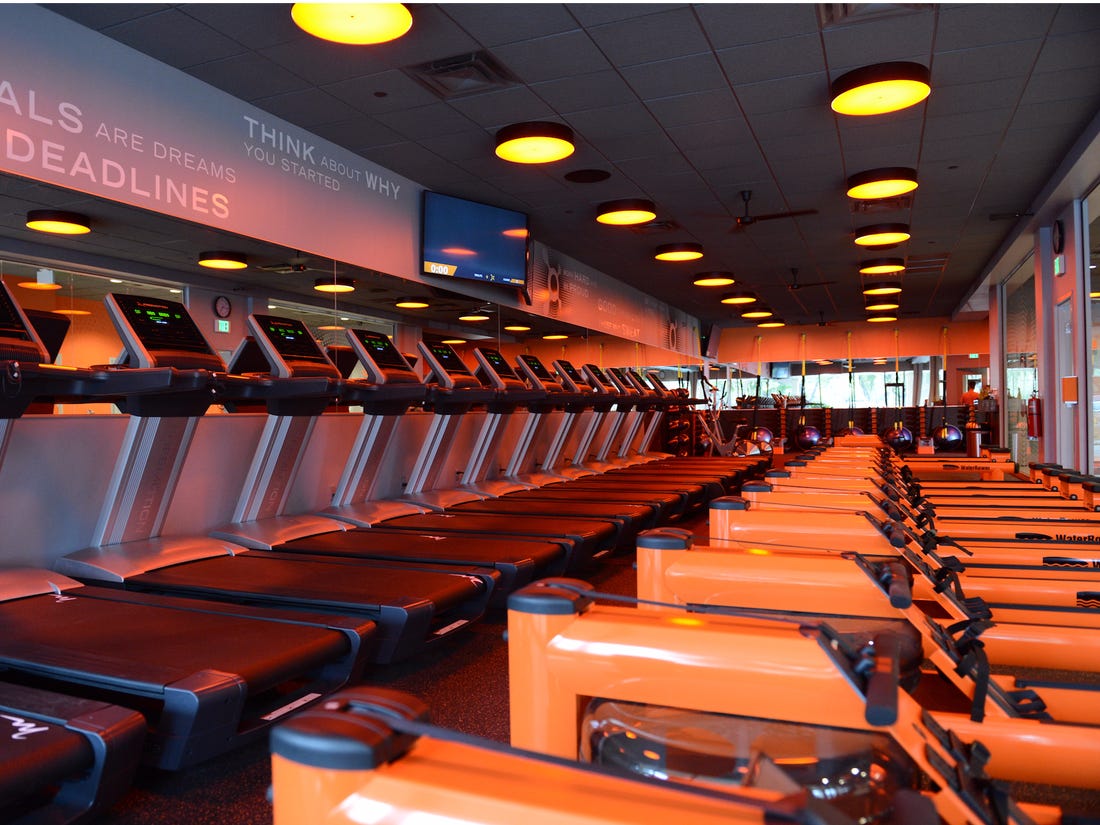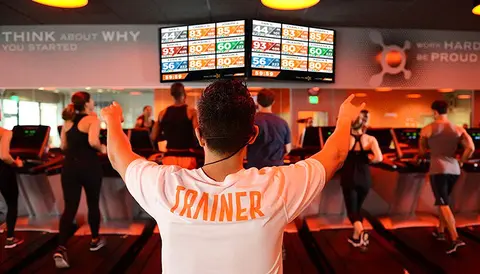
The best online fitness resource you'll ever need. We filter out the BS to ensure you meet your health and fitness goals!

The best online fitness resource you'll ever need. We filter out the BS to ensure you meet your health and fitness goals!

Orangetheory is one of the biggest, fastest growing fitness programmes in the world. It has some hardcore devotees and proponents cite some quite incredible success stories as they proselytize.
But what is Orangetheory and what can it do for you?
Fitness guru Ellen Latham began Orangetheory in a Florida studio in 2009. Since then, it’s caught on and taken the world by storm. Over 500 separate venues were hosting her classes with its first decade. It came to European destinations like Great Britain in 2017.
Their Orange 60 sessions are so named because they last one hour. This hour is divided into five distinct training segments (no pun intended). Each segment centres on a station, with each station putting participants through either a heavy cardio blast or moderate weights-based exercise: think spin, rowing, running, plyometrics, compound lifts and so on.
Each session is also designed to put you into a heightened metabolic state. This state should last for around 36 hours, during which your body will continue burning calories at an accelerated rate.
Orangetheory relies almost entirely on high-intensity interval training (HIIT). HIIT pushes you as hard as possible for short bursts (intervals), meaning that you’re able to go full throttle for a lot longer than a simple sprint program might allow. You get your downtime between intervals before jumping straight back in.
In Orangetheory, this is represented by the lower-intensity cardio and weights stations scattered amongst the really hard stuff. You may have a relatively gentle jog book-ended by hardcore compound lifts and full spin sprints, straight into a base pace walk before hitting fast pace plyos.
Orangetheory is far from the only program making use of HIIT, though it has certainly done a lot to popularise it. HIIT has become incredibly popular in gyms and studios around the world in recent years due to its ability to bring about quite considerable fitness and strength adaptations whilst eliciting several mechanisms that aid weight loss.
In fact, an ever-increasing body of research has shown that HIIT is far more effective and time-efficient than standard cardio for building up H02 max and burning calories.
One landmark study looked at two groups over a fortnight’s period. One group completed six sessions of HIIT style exercise- in this case, 30 second sprints on upright cycles interspersed with brief rest periods. The other group took part in six 90-120 minute sessions of moderate-intensity cycling, maintaining relatively constant, steady paces. This all resulted in the first group performing 2.5 hours of exercise and the second performing 10.5. Both groups showed the same increases in endurance capacity and overall fitness, despite this disparity in exercise duration.
Another study has shown that a mere 10 minutes spent on an upright cycle, three times per week, can boost endurance capacity in those who are sedentary or overweight, as long as those 10 minutes are spent performing HIIT style sprints interspersed with lower paced work. Several health and fitness markers, like V02 max and blood pressure, saw significant improvements.
Aside from the scientific benefits underpinning HIIT’s success, there is also the fact that many people enjoy it immensely, especially when compared to more traditional, continuous, steady-state cardiovascular workouts. As long-term maintenance forms a cornerstone of active, healthy living, this is no small thing.
HIIT relies on you knowing how hard you are pushing yourself, how hard you should be pushing yourself, and how hard you can push yourself.
Perception can go some way, here: many people are able to gauge their limits and work appropriately, flirting with the very edge of exhaustion without every fully giving into it. However, many people cannot do this. We’ve all seen people at the gym who think they’re giving themselves a really hard time when they’re going fairly light, simply because they have no proper experience of hard work to relate to. Basing on perception is, also, fairly unscientific: for more reliable data, and to cut out the vagaries of perception, other measurements are needed.
This is where heart rate-based training comes into its own. Orangetheory use heart rate monitors to break down various paces and effort levels into this kind of hard data to help guide their participants’ workouts. Of these effort levels, a ‘base pace’ is 71-83% of a participant’s max heart rate; ‘push pace’ is 84-91%; and full ‘all out’ sprint work is 84%+. Participants are fed these data in real time, so they and their instructors know exactly how their bodies are responding to any given stimulus, and how long they are managing to spend in each target zone.
These zones are cycled through in an Orangetheory workout: each of the five segments is dedicated to one, so that a variety of intensities, effort levels and energy mechanisms are employed and reliably maintained.
By providing each member with a heart-rate monitor, Orangetheory can monitor your five zone interval training sessions. The five zones are grey, blue, green, orange, and red.
Of these:
During your 60-minute Orangetheory workout, your instructor will continuously push you to hit your orange zone. The theory goes that this will elicit a greater ‘afterburn’ effect. Your metabolic rate will be increased for up to 36 hours post-exercise- which can be anything up to an extra 1,000 calories burned.
But what is this ‘afterburn’? Experts know it as excess post-exercise oxygen consumption (EPOC). It occurs when your rate of oxygen intake increases after hard training. It is estimated that around five calories are burned for every litre of oxygen consumed: to boost the afterburn to its full potential, you have to push your heart rate past 85% of its maximum during training. This is the ‘Orange Zone’ behind ‘Orange Training’.
This is also why instructors won’t let you cruise along in the green zone indefinitely. They know they need to bring you into the Orange Zone as often as possible, for as long as possible. They rarely fail in this task.

There are a few pieces of advice that anybody beginning Orangetheory should bear in mind- it can be quite an overwhelming practice, but these should help to make your first few weeks more manageable.
It’s a cliché by now, but it still holds in many cases: focus on doing you and ignore what others are doing. There will be lots of people in any given class, from all walks of life, of all levels of ability and experience. If somebody is performing a lot better than you, look up to them, aspire to be like them and use them as a template for your own goals, but don’t compare yourself to them.
Nobody will ever do anything perfectly and everyone has room to grow. Don’t feel bad that this applies to you- it will apply equally to them. Your first session will push you to your limit. This is all that can be asked of anybody.
Also know that there is a suitable modification for every exercise. If you’re struggling with any of the weight training, for example, the instructor will be able to modify it to better suit you, your skillset and level. A class should be tough, not uncomfortable or unattainable.
With this in mind, you need to know two things. First, that 12 minutes in the orange heart rate zone is the goal- every class will build you to this. However, secondly, this is a goal, not an expectation.
It is incredibly hard to maintain the orange zone for 12 minutes, especially when you first start out. Get yourself to the orange zone, stay for as long as you can, then pull back a bit.
You may be able to sustain 84%+ two or three months into training. Maybe more, maybe less. The main thing is to work towards it, not berate yourself for not being there from the off.
Also, though some adherents may pride themselves on the extremity of their training, this is not a must- nor is it even always advisable. You want to leave a workout feeling tired but refreshed, beaten down but empowered.
You don’t want to get so sore that you can hardly move for the rest of the week.
At the most, you should spend 12 minutes feeling uncomfortable. This is enough to elicit the adaptation you need. There is no room for pain in an Orangetheory class.
You will be hooked up to a heart rate monitor, which will in turn be hooked up to a screen. This is a must- without it, there is no knowing if, when or for how long you hit the orange zone. You need to aim to be able to push yourself into that 84%+ heart rate for 12-20 minutes if you want to adaptations inherent to Orangetheory: without this, EPOC won’t occur.
So, you cannot commit to Orangetheory if you’re uncomfortable with having your vitals monitored and shared. It’s too baked into the mould to be ignored!
Orangetheory is one of the best exercise systems going for weight loss and adaptation. It elicits EPOC as a matter of course in a friendly, high energy environment.
All classes are also pretty standardised, so that you know what you’re getting in each one and standards are similar across the board.
If you want a good quality workout guaranteed to help you shift weight, conducted professionally by well-trained instructors, it may be worth checking out.